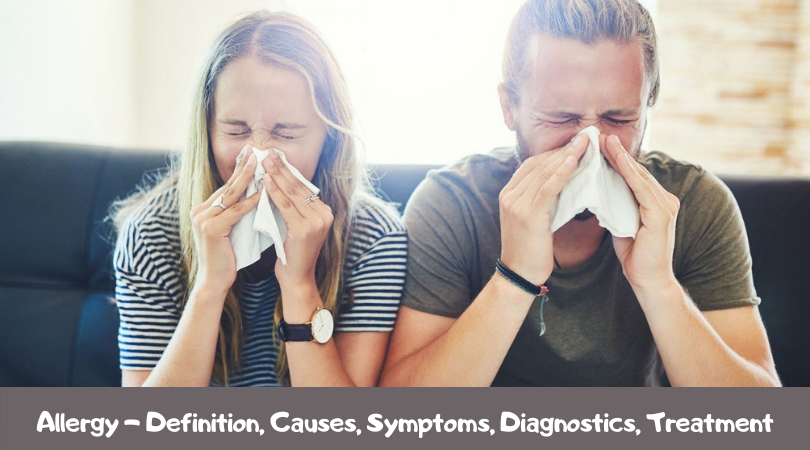All You Need to Know About Allergic Asthma

It is unlikely that any disease underwent the same evolution in the treatment as happened with bronchial asthma (BA). According to recent data, asthma is based on a chronic inflammatory process in the bronchi, which is associated with 4 components (forms) of bronchial obstruction:
- acute obstruction – caused by spasm of the smooth muscles of the bronchi;
- subacute obstruction – due to edema of the bronchial mucosa;
- chronic obstruction – blockage of the bronchi, mainly their terminal sections, with a viscous secretion;
- irreversible (sclerotic) obstruction – due to the development of sclerotic changes in the wall of the bronchi during a long and severe course of the disease.
Morphological changes in BA are characterized by:
- inflammatory infiltration of the bronchi with the presence in the infiltrate of a large number of mast cells, T-lymphocytes, macrophages, eosinophils;
- the accumulation of viscous mucus in the lumen of the bronchi;
- destruction and desquamation of the bronchial epithelium, an increase in the number of goblet cells and their hyperfunction;
- a sharp decrease in the function of the ciliated epithelium;
- hyperfunction of the submucous glands;
- interstitial edema, increased microvascular permeability;
- violation of microcirculation;
- sclerosis of the bronchial wall (with prolonged course).
The BA strategy is currently being defined by GINA. Earlier the severity of asthma was the fundamental point, but after 2006 the advantage was gained by the ability to control the course of this disease. At the same time, no one refused to classify BA according to the etiological principle reflected in the ICD-X (International Classification of Diseases X revision), prepared by WHO in 1992.
Paying tribute to the progressive aspects of the GINA global strategy, we understand that its driving element is the desire of international pharmaceutical corporations to consider the main aspects of the etiology, pathogenesis of BA, approaches to its treatment based on the pharmacological drugs they produce (glucocorticosteroids (GCS), bronchodilators, leukotriene modifiers, etc.) However, this cannot be condemned since the use of modern bronchodilators and inhaled glucocorticosteroids (ICS), in fact, revolutionized the treatment of asthma and gave millions of asthma patients a chance for a fairly full life. Negative, in our opinion, is the neglect of GINA etiology of asthma, asthma “drift” towards chronic obstructive pulmonary disease (COPD), which is explained by the “omnivorousness” of ICS and other reasons.
At the same time, “old” allergists remember about the different clinical course of “everyday”, nutritive, “epidermal” BA, clinical and pathogenetic variants of BA, etc., which had a certain clinical meaning and dictated the need for a differentiated approach to treatment.
In this regard, the European European Academy of Allergy and Clinical Immunology (EAACI) considers it natural to use the term “allergic bronchial asthma” (ABA), the share of which is about 80% in the structure of children and over 60% in the structure of BA in adults.
Reasons factors
The main etiological factors of allergic bronchial asthma are:
- house dust mites;
- mold fungi (Penisillium, Alternaria, Cladosporium);
- waste products of cockroaches;
- wool and waste products of warm-blooded domestic or laboratory animals;
- wool and waste products of synanthropic animal species (mice, rats);
- professional allergens;
- food allergens.
Trigger factors are of great importance in allergic bronchial asthma, which include:
- inhalation – numerous chemical aerosols contained in abundance in the atmosphere of settlements;
- infections;
- oral agents – food, additives;
- parenteral drugs, vaccines and serums;
- insect bites, etc.
There are also risk factors for BA:
- internal – genetic predisposition, atopy, bronchial hyperreactivity;
- external – hypertension, professional agents, active and passive smoking, pollutants, infections.
Clinical symptoms
Establishing a diagnosis of allergic bronchial asthma in typical cases is not difficult. To do this, it is enough to correctly collect anamnesis and identify the leading clinical symptoms: bronchospasm phenomena, asthma attacks. Other possible symptoms of allergic bronchial asthma include:
- cough, more often at night and during physical exertion;
- occasional “remote” wheezing;
- periodic chest stiffness, shortness of breath.
Symptoms often worsen at night or in the morning, occur or worsen with physical exertion, viral infection, exposure to hypertension, pungent odors, smoking, temperature changes, emotions (crying, laughter), taking certain medications. The diurnal and seasonal variability of symptoms is characteristic.
Diagnostics and differential diagnostics
After collecting complaints, anamnesis and identifying signs characteristic of allergic bronchial asthma, regardless of the level of the medical institution, skin testing with a set of mixed-AH for screening of allergic diseases and a study of respiratory function (RRF) or at least peak flowmetry should be performed. In case of a positive reaction to one of mixed hypertension, it is necessary to consult an allergist, setting a prick test with a set of monoAG (clarification of the etiological factor). The study of external respiration function with the identification of indicators characteristic of BA is of great importance:
- peak expiratory volumetric velocity (POSevd) and forced expiratory volume in the first second (FEV1) 12% (or 200 ml) according to the results of a pharmacological test with a short-acting β2-agonist;
- diurnal variability of POSVD and FEV1> 20%.
For the purpose of differential diagnosis, it is recommended to consult a pulmonologist with an X-ray examination (in order to exclude COPD, alveolitis, tuberculous bronchoadenitis, tracheobronchial dyskinesia, hereditary or occupational diseases), an otorhinolaryngologist (diseases of the nose and paranasal sinuses).
In children, when establishing a diagnosis of ABA, one should keep in mind such diseases as cystic fibrosis, congenital immunodeficiency, congenital heart disease, milk aspiration.
In some cases, the doctor may prescribe provocative (nasal, inhalation) tests with hypertension, determination of the level of general and specific IgE, consultation of a geneticist, occupational pathologist, and also:
- body plethysmography;
- bronchoprovocation tests (with histamine, acetylcholine, physical activity) based on a spirometric study;
- chest x-ray;
- diagnostic bronchoscopy;
- X-ray of the paranasal sinuses.
As noted in GINA (2006), pulmonary function tests using spirometry or expiratory peak flow are recommended as adjuncts for diagnosis and monitoring during treatment. The key to an accurate diagnosis of BA is measuring the variability of airway restriction, which also serves as a good method for assessing disease control.
When carrying out the differential diagnosis of allergic bronchial asthma, the allergist should always take into account such diseases as allergic rhinitis (AR), COPD and exogenous allergic alveolitis. AR in most cases is a precursor of allergic bronchial asthma, therefore, while observing patients with AR, it is necessary to constantly monitor the dynamics of the patient’s complaints (indications of the appearance of bronchospasm, spastic cough or suffocation), external respiration function data (speed indicators, latent bronchospasm).
COPD is not characterized by the presence of atopy, AR, reversibility of bronchial obstruction. COPD is characterized by smoking, occupational hazards as predisposing factors, as well as a greater effectiveness of anticholinergics compared to β2-agonists, periodically – the presence of purulent sputum, radiological signs of emphysema and bronchitis.
For ABA, in contrast to other types of BA, there is a characteristic relationship between the occurrence of seizures and the effects of hypertension and, conversely, their disappearance during elimination, positive skin and laboratory tests with probable (according to the history) hypertension, and an increased level of total IgE.
Treatment
The main principles of allergic bronchial asthma treatment are:
- Elimination or minimization of contact with causative hypertension;
- Pharmacotherapy (mainly in the form of aerosols);
- Specific immunotherapy (SIT);
- Education of the sick.
Pharmacotherapy with ABA, in accordance with the latest GINA recommendations, should make it possible to control its course, i.e, achieve:
- absence (twice or less a week) of daytime symptoms;
- no limitation of physical activity during the day;
- absence of asthma symptoms, forcing to wake up at night;
- absence (twice or less a week) of the need for symptomatic treatment;
- normal or close to normal indicators of pulmonary function;
- absence of exacerbations.
When monitoring a patient’s condition, do not rely solely on the clinical signs of allergic bronchial asthma. It is necessary (if possible) to control biochemical markers of inflammation, as well as to carry out functional studies. Due to the high cost and the frequent absence of such diagnostic methods as endobronchial biopsy, sputum examination with determination of the number of eosinophils and measurement of exhaled nitric oxide at the disposal of a practitioner, it is recommended to correct treatment based on an assessment of impaired lung function.
Drugs for the treatment of allergic bronchial asthma are subdivided into control drugs and symptomatic drugs.
Control drugs are usually taken daily for a long time and are the basic means for maintaining control over asthma (mainly due to their anti-inflammatory effect). These include ICS, leukotriene modifiers, prolonged inhalation and oral β2-agonists, theophylline, cromones (in children), anti-IgE drugs, systemic corticosteroids, oral antiallergic drugs, etc. Some of the most effective control agents are ICS.
Symptomatic agents act as adjuvants designed to quickly relieve bronchial obstruction and relieve symptoms. These drugs include drugs of fast-acting inhaled β2-agonists, GCS, anticholinergics, theophylline, as well as short-acting oral β2-agonists. Rapid-acting inhaled β2-agonists are the drugs of choice for relieving bronchial obstruction and preventing asthma attacks during exercise in adults and children. An increase in the use of symptomatic drugs, especially in the daytime, indicates a deterioration in the degree of control over asthma and requires a revision of the patient’s treatment plan.
Modern technologies for treating BA largely depend on the method of drug delivery to the bronchi.
Currently, NBs are increasingly used to relieve asthma attacks, in which nebulized forms of a number of bronchodilators (fenoterol, ipratropium bromide), corticosteroids, and expectorants are used.
The nebulizer method of inhalation therapy has been known since 1859. Its essence consists in inhaling a solution of a drug in the form of a fine aerosol. In NB, the transformation of a liquid into an aerosol occurs not by heating the solution to a boil, as in steam inhalers, but by means of ultrasound or a flow of gas (air) under pressure.
Ultrasonic NB sprays the solution with ultrasound vibrations. They are compact, practically silent, but a number of drugs (such as antibiotics, immunomodulators and ICS suspensions) can be destroyed by ultrasound.
Compressor NBs form an aerosol cloud (particle size – 2-5 microns) by forcing through a narrow hole in the chamber containing the medicinal solution, a powerful airflow, forced by the compressor.
Depending on the purpose, nebulizers are subdivided into devices for:
- home use. The use of nebulizers at the prehospital stage makes it possible to more effectively stop asthma attacks and reduce the number of hospitalizations for exacerbation of asthma;
- professional use. Technical characteristics allow them to be successfully used in hospitals and clinics, where there is a need for a large number of inhalation therapy sessions daily.
The main indications for the use of nebulizer therapy in asthma are:
- treatment of exacerbation of asthma, prolonged attack, status asthmaticus;
- planned therapy for persistent asthma of moderate severity and severe course, when it is difficult to achieve control over the disease with the help of basic therapy in standard doses;
- childhood, especially the first years of life;
- severity of the condition (lack of effective inhalation);
- impossibility of coordination of inhalation and pressing on the AIM canister.
Contraindications to nebulizer aerosol therapy:
- pulmonary hemorrhage and recurrent hemoptysis;
- traumatic spontaneous pneumothorax with pulmonary emphysema;
- cardiac arrhythmia and severe heart failure;
- individual intolerance to the inhaled drug.
It is necessary that polyclinics, hospitals, and ambulances be equipped with NB.
BA therapy is prescribed in accordance with five stages. The intensity of treatment (type, dose and/or frequency of administration of drugs) is increased with each stage, which is necessary to achieve control over the disease. At each stage, the use of symptomatic remedies on demand is justified. At stage 2-5, it is necessary to use various control means. If control over asthma is not achieved, one should proceed to therapy one step higher. With stable disease control, it is possible to go down a step to select lower dosages for treatment and maintain control over the disease.
Prevention
Prevention of the development and exacerbations of asthma may include the implementation of such measures as elimination or reduction of contact with causative hypertension or trigger factors (smoking, pollutants, household chemicals, cosmetics, professional agents at work). The use of medicines should be minimized as much as possible, a hypoallergenic diet should be provided.
Rehabilitation
In asthma, SPA treatment can be recommended, in which basic therapy or SIT is supplemented by appropriate climatic factors, speleotherapy, physiotherapy procedures, psychotherapy, etc.


